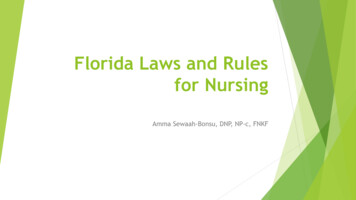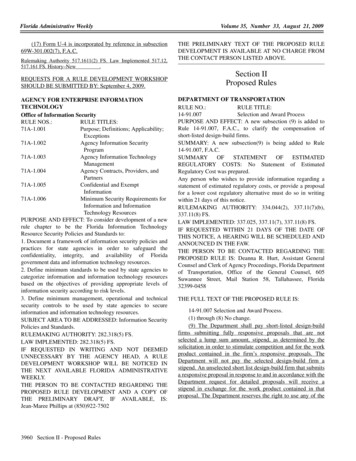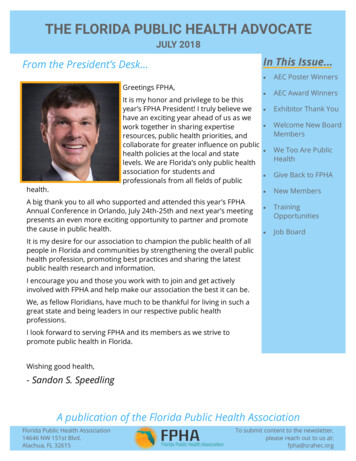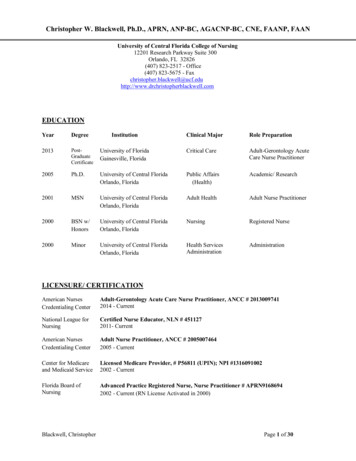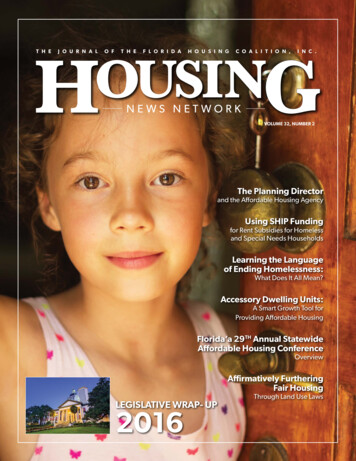
Transcription
T H EJ O U R N A LO FT H EF L O R I D AH O U S I N GC O A L I T I O N ,I N C .NEWS NETWORKVOLUME 32, NUMBER 2The Planning Directorand the Affordable Housing AgencyUsing SHIP Fundingfor Rent Subsidies for Homelessand Special Needs HouseholdsLearning the Languageof Ending Homelessness:What Does It All Mean?Accessory Dwelling Units:A Smart Growth Tool forProviding Affordable HousingFlorida’a 29TH Annual StatewideAffordable Housing ConferenceOverviewAffirmatively FurtheringFair HousingLEGISLATIVE WRAP- UP2016Through Land Use Laws
EXECUTIVE COMMITTEEGeorge Romagnoli, CHAIRPasco County Community DevelopmentEd Busansky, IMMEDIATE PAST CHAIRFirst Housing Development CorporationIN THIS ISSUE:1FROM THE EDITOR2Grounded Solutions NetworkAileen Pruitt, VICE CHAIRPNCBen Johnson, TREASURERSeltzer Management Group, Inc.2Mark Hendrickson, AT LARGELEGISLATIVE WRAP-UP2016Robert Von, SECRETARYMeridian Appraisal Group, Inc.THE HOUSING NEWS NETWORKVOLUME 32, ISSUE 23SHIP DISTRIBUTION ESTIMATESfor Fiscal Year 2016-17The Hendrickson CompanyJeff Kiss, AT LARGEKiss & Company, Inc.Melvin Philpot, AT LARGEDuke EnergyBOARD OF DIRECTORSRobert Ansley, Jr.Orlando Neighborhood Improvement Corp.Stephanie Berman-Eisenberg9THE PLANNING DIRECTORand the Affordable Housing Agency11 USING SHIP FUNDING FORRENT SUBSIDIESfor Homeless and Special Needs HouseholdsCarrfour Supportive HousingSuzanne CabreraHousing Leadership Council of Palm BeachCounty, Inc.Charles Elsesser13 LEARNING THE LANGUAGE OFENDING HOMELESSNESS:What Does It All Mean?Community Justice ProjectBradford GoarFlorida Power and LightDonald Hadsell16 CREATING INCLUSIVECOMMUNITIES IN FLORIDANIMBY Book ReleasedCity of SarasotaJack HumburgBoley Centers, Inc.Barbara InmanHabitat for Humanity of FloridaChristine LongMetropolitan MinistriesLeroy MooreTampa Housing AuthorityWilliam O’DellShimberg Center for Housing StudiesChristine RuizBank of AmericaADVISORY COUNCILDavid Christian17 ACCESSORY DWELLING UNITS:A Smart Growth Tool for ProvidingAffordable Housing21 FREE LEGAL SERVICES16for Florida Nonprofits Engagedin Affordable Housing22 FLORIDA’S 29TH ANNUALSTATEWIDE AFFORDABLE HOUSINGCONFERENCE :Pre-Conference Short Course, ConferenceAgenda, and Registration FormRegions BankMarilyn DraytonWells FargoHelen Hough Feinberg27 AFFIRMATIVELY FURTHERING FAIRHOUSING11Through Land Use LawsRBC Capital MarketDebra KoehlerSage Partners, LLC31 SHIP CLIPSFrequently Asked SHIP QuestionsNancy MerollaFlorida Community BankTim O’MalleyAmeriNational Community ServicesSTAFFAida Andujar Technical AdvisorMichael Chaney Technical AdvisorCharlene Chen Finance ManagerPam Davis Workshop Coordinator33 MEMBERSHIP APPLICATION34 ABOUT THE COALITION35 AFFORDABLE HOUSINGCONSULTING SERVICESFor Local Governments, Nonprofits,and their Developer and Financial Partners.Lisa Hoffmeyer Technical AdvisorRose Phillips Research AnalystSusan Pourciau Director, Homeless,Training and Technical Assistance36 FLORIDA HOUSING COALITIONBOARD OF DIRECTORS & STAFF22Jaimie Ross President & CEOBen Toro-Spears Technical AdvisorKimberly Spence Technical AdvisorFLORIDA HOUSING COALITION, INC.1367 E. LAFAYETTE STREET, SUITE C TALLAHASSEE, FL 32301 PHONE: (850) 878-4219 FAX: (850) 942-6312Caleena Shirley Technical AdvisorTHE FLORIDA HOUSING COALITION is a nonprofit, statewide membership organization whose mission is to bring together housing advocates and resourcesJohnitta Wells Conference & EducationManagerso that Floridians have a quality affordable home and suitable living environment. The Housing News Network is published by the Florida Housing Coalition as aservice to its members, housing professionals and others interested in affordable housing issues. Jaimie Ross, Editor, Rose Phillips, Associate Editor, and Lynne Takacs,Graphic Design Email: info@flhousing.org, Website: www.flhousing.org.
EDITOR’s LETTERFrom the EditorGROUNDED SOLUTIONS NETWORKLittle or no personal information is typically included in From the Editor; please allow me this indulgence.I started working in earnest on affordablehousing public policy in the early 1990s.Once the Sadowski Act became law,creating a dedicated financing resourcefor affordable housing, it was time toJAIMIE ROSSaddress the other half of the affordablehousing delivery equation: land use planning. That immediately led me to study the Montgomery County “ModeratelyPriced Dwelling Unit” (MPDU) ordinance which was creating thousands of affordable homes economically integratedseamlessly into new developments. TheMPDU ordinance is inclusionary zoning(IZ); an ordinance that requires market rateresidential development to include a smallpercentage of affordable housing as a condition of development approval.of 2000. Community land trusts (CLTs) are dedicated tomaintaining affordability in perpetuity: a perfect matchfor inclusionary zoning. The CLT can help with theadoption, implementation, and stewardship of all theunits created pursuant to the inclusionary ordinance.There are over 400 inclusionary zoning ordinancesthroughout the nation and about 200 CLTs. And now,finally, there is national nonprofit bringing these two toolstogether—it’s called Grounded Solutions Network, andI’m proud to serve on the Executive Committee of itsnewly formed Board of Directors.Grounded Solutions Network (GSN) willsupport the work of inclusionary zoningprograms and community land truststhroughout the nation, but most significantly,GSN makes the connection between the two:CLTs and IZ. And while I feel some frustration that it is more than two decades sinceI produced the video on pairing CLTs withIZ, the timing for GSN is great!With a grant from the RockefellerFoundation, I traveled across the nationconducting video interviews with localgovernment administrators of inclusionaryzoning programs. I also interviewed thedevelopers in each of these communities toThe country is increasingly aware of theget their experience-based opinions aboutdetriment that ensues when segments ofthe local inclusionary zoning ordinance.society are prevented from accessing opportrustlandcommunityHere’s the crux of what I discovered: (1)tunity because of where they live. TheINSTITUTEadopting an inclusionary zoning ordinanceoft-heard “no child’s future should be deteris no easy task; (2) the rubber hits the road when the ordimined by his or her zip code” is now more commonlynance is implemented; and most importantly, (3) if theunderstood. Local land use tools that lead to the develaffordable units created pursuant to the ordinance do notopment of affordable housing in areas of opportunity,remain affordable in perpetuity, it’s probably not worthwhether new development or redevelopment, coupledgoing through all the effort. The video I made showcasedwith permanent affordability is a clear path forwardDavidson North Carolina, which required that 12% of allfor overcoming the zip code challenge. We now havenew housing was affordable and had those units deededa national organization, Grounded Solutions Network,to a 99 year land lease program run by a local nonprofit.dedicated to this work. The Florida Housing Coalition’sCommunity Land Trust Institute is pleased to partnerAll this inclusionary housing expertise led me to createwith Grounded Solutions Network to augment our workthe Florida Community Land Trust Institute in Januarythroughout Florida. HNNfloridaHOUSING NEWS NETWORK VOLUME 32, ISSUE 2 AUGUST 20161
LEGISLATIVE WRAP-UPLegislative Wrap-Up2016Mark Hendrickson and Jaimie RossFirst and foremost, the efforts of the Sadowski Coalition and Sadowski Coalition Affiliates resulted in over 200 million inappropriation for affordable housing in fiscal year 2016-17. This session brought back a robust SAIL, SHIP, and appropriationfor ending homelessness, together with tools to make great inroads using the best practice of rapidly re-housing peopleexperiencing homelessness using the housing first model.The table on page 7 shows the Governor’s proposedbudget, the housing appropriation offered by the Senate,the housing appropriation offered by the House, and thefinal resolution. The 200.1 million in State and LocalHousing Trust Fund monies is roughly a 25 millionincrease over last year’s funding level, and is the highestfunding level in nine years.Similar to last year’s appropriation bill, the 2016-2017 appropriations bill includes proviso language for slightly under 4% ofthe SHIP appropriation to be used for homeless Continuum ofCare assistance— 5 million for the Challenge Grant administered by the State Office on Homelessness and 200,000 fortraining and technical assistance to Continuum of Care leadagencies and their partners. An additional 500,000 of SHIP2THE FLORIDA HOUSING COALITION FLHOUSING.ORGfunds are designated by proviso language for the AffordableHousing Catalyst Program.In addition to the 32.3 million in State Housing Trust Fundmonies appropriated for SAIL, Florida Housing is authorized to spend 75- 80 million of its Guarantee Programfunds on SAIL. 20 million of SAIL funds are designatedfor workforce housing, which is targeted to households up to80% of the Area Median Income (AMI), and/or for housingin the Keys that is affordable to households up to 140%AMI. The 2016/17 appropriations bill also contains provisolanguage requiring Florida Housing to spend 10 millionof its State Housing Trust Fund appropriation on housingfor people with developmental disabilities, similar to theproviso requirements in the last three appropriations bills.
SHIP FUNDING FY 16-17SHIP DISTRIBUTION ESTIMATESFOR FISCAL YEAR AYBREVARDCOUNTYSHARE/CITY 4,4721,540,146424,326HAMILTON350,000350,000PALM BEACH350,000350,000Boca 0172,468,753350,000Boynton Bch460,369HERNANDO1,125,196Delray ,213Largo510,305357,958INDIAN RIVER916,213Coral FERSON350,000350,000Deerfield Bch484,975LAFAYETTE350,000350,000Ft. 2792,698,989Hollywood915,678Lauderhill439,941Cape CoralMargate353,339Ft. 2LEVY350,000350,000Pompano 6,651350,000350,0001,067,904955,027112,877Punta EMiamiDE SOTO350,000350,000Miami BeachDIXIE350,000350,000Miami 16,451350,0001,796,2001,622,936St. ter Haven240,818PUTNAM471,312471,312ST. JOHNS1,364,5171,364,517ST. LUCIE1,829,643454,483267,860Ft. Pierce1,107,300Port St. LucieSANTA 5,030City of 22,166,707Ocala444,338Palm Coast333,984BradentonCOLUMBIAPensacola673,988West Palm BchHOLMESCoconut CreekPembroke 171,125,196679,500FRANKLIN6,251,699HARDEEPalm /CITY UNTYTOTAL815,270Panama COUNTYSHARE/CITY SHARE1,758,650North MiamiVOLUSIA402,781Daytona 000124,461,250 5,897Disaster Relief Holdback &Compliance MonitoringHomeless Transfers & Catalyst5,700,000514,556Ft. Walton Bch350,000OKEECHOBEE133,790350,000350,000TOTAL ESTIMATEDAPPROPRIATION135,500,000Conf. Report HB 5001* (less 5.2 million for Homeless, 5 million holdback for Disaster Relief, 500,000 for Catalyst, and Compliance Monitoring)HOUSING NEWS NETWORK VOLUME 32, ISSUE 2 AUGUST 20163
Sadowski Coalition MembersBusiness and Industry GroupsAssociated Industries of FloridaCoalition of Affordable Housing ProvidersFlorida Apartment AssociationFlorida Bankers AssociationFlorida Chamber of CommerceFlorida Green Building CoalitionFlorida Home Builders AssociationFlorida Manufactured Housing AssociationFlorida RealtorsFlorida Retail FederationAdvocates for the Elderly, Veterans,Homeless and Special NeedsAARP of FloridaFlorida Assoc. of Housing & Redevelopment OfficialsFlorida Coalition for the HomelessFlorida Housing CoalitionFlorida Legal ServicesFlorida Supportive Housing CoalitionFlorida Veterans FoundationFlorida Weatherization NetworkLeadingAge FloridaThe Arc of FloridaUnited Way of FloridaGovernment &Planning OrganizationsAmerican Planning Association, Florida ChapterFlorida Association of CountiesFlorida Association of Local Housing Finance AuthoritiesFlorida League of CitiesFlorida Redevelopment AssociationFlorida Regional Councils AssociationFaith Based OrganizationsFlorida Conference of Catholic BishopsFlorida ImpactHabitat for Humanity of FloridaVolunteers of America4THE FLORIDA HOUSING COALITION FLHOUSING.ORGSB 1534 – The “Homeless Bill”This bill, passed and signed into law as CS/CS/SB 1534,includes numerous provisions to expand Florida’s policyand funding framework for homeless assistance, as wellas other changes to increase the flexibility and accountability of Florida’s housing programs. Highlights of SB1534 are provided below.Changes to Florida HousingFinance Corporation Programs Amends 420.507(22), Florida Statutes, to allow SAILto provide more than 25% of project costs for developments in counties or rural areas of counties that do nothave existing units set aside for homeless persons (asdefined in 420.621(5)), or where persons are residing intime-limited transitional housing or institutions due toa lack of permanent affordable housing. These developments must be supported by a local homeless assistanceContinuum of Care (CoC), be developed by nonprofitapplicants, be small properties as defined by FloridaHousing rules, and be mentioned in the local CoC planrecognized by the State Office on Homelessness. Priorto this change, such developments would not have beenable to receive a SAIL loan for more than 25% of theirproject costs unless they explicitly served extremelylow-income (ELI) households. This amended sectionalso allows Florida Housing to forgive loans held bythese projects. Amends 420.5087(6)(k), F.S., to require SAIL developments to use the same rent limits provided for LowIncome Housing Tax Credit units that are applicableto the income limits for the SAIL units. Previously, thestatute did not allow rent limits for most SAIL units. Amends 420.507(35), F.S., to remove the 2-year timelimit for prohibiting an applicant or their affiliate thathas engaged in material misrepresentation or fraudulentactions from participating in Florida Housing programs.Florida Housing now has discretion to determine howlong such entities may be barred from participating inits programs, and may bar them indefinitely.
Adds subsection (50) to 420.507, F.S., allowing Florida Housing to reserve a minimumof 5 percent of the annual appropriation fromthe State Housing Trust Fund for housingprojects designed and constructed to servepersons with a disabling condition, with firstpriority given to projects serving persons witha developmental disability. Funding will beprovided as forgivable loans to nonprofitswhose primary mission includes servingpeople with disabling conditions.SADOWSKI PRESS CONFERENCESadowski members called upon the Legislatureto use the housing trust fund for housing. Adds 420.9089 to the Florida Statutes,encouraging Florida Housing to use thestate’s National Housing Trust Fund (NHTF)allocation to reduce homelessness and therisk of homelessness.Provisions for State Office onHomelessness andContinuums of Care Amends 420.622(3)(b), F.S., to require theState Office on Homelessness (SOH) todevelop a system to collect and analyze datafrom all lead agencies to assess trends andimpacts. NOTE: This statutory change doesNOT require SOH to develop a statewideHomeless Management Information System(HMIS) or study the possibility of doing so. Amends 420.622(4), F.S., to clarify thatChallenge Grant funds are distributed bySOH to local Continuum of Care lead agencies, and removes the requirement that awardlevels be based upon a CoC’s level of need. Amends 420.622(4)(a), F.S., to clarify thatfunds or in-kind contributions used as aChallenge Grant match cannot have beenused as leverage or match for other projects,and requires that there be a written commitment certifying the match.HOUSING NEWS NETWORK VOLUME 32, ISSUE 2 AUGUST 20165
Expands upon 420.622(6), F.S., to require SOH todevelop specific objectives for evaluating performanceand outcomes of Continuum of Care lead agencies thatreceive grant funds; require that Challenge Grant funding be based on the lead agencies’ “overall performanceand their achievement of specified objectives”; andreplace the previous “output-based” evaluation criteriawith “outcome-based” criteria, including the numberof persons or households that are no longer homeless,the rate of returns to homelessness, and the number ofpersons who become employed. Amends 420.624(3), F.S., to require SOH to provide “amethodology for assessing performance and outcomes”and a framework for reporting data in local Continuumof Care plans. Amends 420.624(7), F.S., to include Rapid Re-Housing(RRH) as a component that should be included inlocal CoC plans. Adds 420.6265 to Florida Statutes, providing legislativefindings and intent for Rapid Re-Housing. This newsection finds that Rapid Rehousing (RRH) is a goodpractice to reduce duration of homeless episodes andmove people out of homelessness, and is cost-effective.CoCs are encouraged to adopt RRH strategies and toinclude them in their local CoC plans.Changes to SHIP Program Amends 420.9072(3)(b), F.S., to extend Florida Housing’sreview period for draft Local Housing Assistance Plans(LHAPs) from 30 to 45 days. Amends 420.9072(7) to allow local governments to useSHIP funds to provide up to 12 months of rent subsidies for very low-income households with at least oneadult who is a person with special needs (as definedby 420.0004, F.S.) or homeless as defined by 420.621,F.S. This amendment codifies proviso language thatwas included in the FY 2015-16 appropriations bill.6THE FLORIDA HOUSING COALITION FLHOUSING.ORGPreviously, Florida Housing’s interpretation of the SHIPStatute and Rule had allowed for SHIP to provide upto 3 months of rental assistance. This subsection, asamended, also clarifies that SHIP funds to provide up to6 months’ rent in eviction prevention assistance, whichhad previously been allowed by Florida Housing’s interpretation of the SHIP Statute and Rule. SHIP assistancewill continue to be allowed for security and utility deposits under this subsection. Amends 420.9075(2)(a) to require SHIP jurisdictions toencourage the involvement of local CoC lead agenciesin its public-private partnerships. Amends 420.9075(3) to encourage SHIP jurisdictions todevelop LHAP strategies for reducing homelessness, andallows SHIP jurisdictions to create regional partnershipsto pool SHIP homeless assistance funds. Amends 420.9075(4) to require rental units that receivemore than 10,000 in SHIP assistance to be monitoredannually for tenant eligibility. This is an increase fromthe previous statutory threshold of 3,000. Amends 420.9075(5) to explicitly allow SHIP jurisdictions to reserve up to 25% of their annual SHIPallocations for rental housing, which is a clarification ofexisting policy. This subsection, as amended, also codifies proviso language included in the previous three years’appropriations bills by requiring SHIP jurisdictions touse at least 20% of their annual allocations for personswith special needs as defined in 420.0004. First priority of these funds is given to people with developmentaldisabilities, with an emphasis on home modifications toallow beneficiaries to maintain homeownership. Amends 420.9075(10) to include a requirement for localgovernment LHAPs to include a description of effortsto reduce homelessness.
Line Item Appropriations and VetoesThe tables below shows line-item appropriations for homeless assistance and housing. Other than the Challenge Grants,which were discussed previously, seven line item appropriations that were signed into law will be funded by GeneralRevenue (GR). Another five line item appropriations will be funded by the State Economic Enhancement & Development(SEED) Trust Fund, which was created in 2011 as a funding source for economic development activities. SEED receives 150 million annually— 75 million each from the Housing Trust Funds and the Transportation Trust Fund. Thevetoed line items include the City of Sarasota Gulf Coast Housing First Initiative, the Jacksonville Downtown InvestmentAuthority’s Urban Homesteading Pilot Program, and the NeighborWorks Florida Collaborative. HNNJAIMIE ROSSJaimie A. Ross is the President & CEO of the Florida Housing Coalition. She initiated the Sadowski Coalition in1991 and continues to facilitate the Sadowski Coalition today. Ms. Ross served as the Affordable Housing Directorat 1000 Friends of Florida, a statewide nonprofit smart growth organization, from 1991-2015. Prior to her tenureat 1000 Friends of Florida, Ross was a land use and real property lawyer representing for profit and nonprofitdevelopers and financial institutions with a law firm in Orlando. Ross is the past Chair of the Affordable HousingCommittee of the Real Property Probate & Trust Law Section of the Florida Bar.MARK HENDRICKSONMark Hendrickson, president of The Hendrickson Company, is a past Chair and serves as an ExecutiveCommittee member for the Florida Housing Coalition. He served as Executive Director of the Florida HousingFinance Agency from its inception in 1981 to 1994. As its first Chief Executive Officer, he led the way in creation ofthe Sadowski Act. The Hendrickson Company specializes in assisting clients in all areas of affordable housing,including finance and related legislative issues. His clients include for-profit and non-profit developers, the FloridaAssociation of Local Housing Finance Authorities, and four County HFA’s.HOUSING TRUST FUND APPROPRIATIONSFISCAL YEAR 2016-2017GOVERNORSAILSENATEHOUSE 97,405,000Housing for DevelopmentallyDisabled 32,300,000*2In recurring budget In recurring budgetFHFC*1FINAL BUDGET 10,000,000 125,760,000 94,405,000 22,300,000 185,800,000 47,000,000 129,800,000HomelessIn provisoIn proviso 5,000,000TrainingIn provisoPart in proviso 700,000SHIP 34,000,000DEOMember ProjectTOTAL HOUSING 5,440,000 0 131,405,000 317,000,000 141,405,000 200,100,000 0 0 0 30,414,438LGHTF SWEEP 172,000,000 0 172,000,000 86,500,000TOTAL SWEEP 172,000,000 0 202,414,438*2 116,914,438SHTF SWEEP*1- SAIL, HAP, PLP and Guaranty Program*2- Plus approximately 75- 80 million of FHFC funds from Guarantee Program (not doc stamps) authorized to be spent on SAILHOUSING NEWS NETWORK VOLUME 32, ISSUE 2 AUGUST 20167
OTHER MEMBER PROJECTSFISCAL YEAR 2016-2017ITEMAMOUNTLINE ITEMSOURCEAGENCYCity of North Miami ElderlyHousing Assistance Program 200,0002216General RevenueDEOPembroke Pines VeteransHome Renovation 1,000,0002216SEEDDEO 75,0002216SEEDDEOBuilding Homes for HeroesADDITIONAL HOMELESS FUNDINGFISCAL YEAR 2016-2017ITEMAMOUNTLINE ITEMSOURCEAGENCYChallenge Grants 5,000,000361/2224From Local Government HousingTrust Fund- same 5 million asshown in Housing TF ChartDCFHomeless HousingAssistance Grants 3,000,000363General RevenueDCFCitrus Health Network for theSafe Haven for Homeless Youth 140,800363General RevenueDCFNational Veterans HomelessSupport in Brevard County 150,000363General RevenueDCFTransition House HomelessnessVeterans Program- Osceola County 150,0002216General RevenueDEOHillsborough Homeless Initiative 200,0002216General RevenueDEOHillsborough Homeless Initiative 600,0002216SEEDDEOClearwater HomelessEmergency Program 100,0002216SEEDDEOSulzbacher Center forWomen (Jacksonville) 1,000,0002216SEEDDEO 500,0002216General RevenueDEOCity of Ft. Lauderdale RapidRe-Housing ProjectHOUSING-RELATED ITEMS THE GOVERNOR VETOEDFISCAL YEAR 2016-2017ADDITIONAL HOUSING FUNDINGITEM8AMOUNTLINE ITEMSOURCEAGENCYCity of Sarasota Gulf CoastHousing First Initiative 250,0002216Special EmploymentSecurityAdministration TFDEO - VETOEDJacksonville DowntownInvestment Authority—UrbanHomesteading Pilot Program 1,000,0002216General RevenueDEO - VETOEDNeighborWorks FloridaCollaborative 500,0002216SEEDDEO - VETOEDTHE FLORIDA HOUSING COALITION FLHOUSING.ORG
LOCAL GOVERNMENTThe Planning Director and theAffordable Housing AgencyBy: Robert Ansley, Jr.Planning for housing has long been an integral part of the city planning function. The future land use plan provides for projectedfuture housing needs within a framework for location and general housing density classifications. Development codes specifyform, type, and density details and generally relate housing development to availability of services. Other aspects includesuch items as housing quality standards, group home regulations, and streamlined permitting. All of this creates a frameworkfor the private sector delivery of housing within a local government’s goals and vision.Many local governments have housing divisions andhousing planners, either as part of a planning office orin a separate department. These departments and staffare often involved in assessing needs, directing resources(especially SHIP, CDBG, HOME, HUD SupportiveHousing Funds, and local bond and other funds), working with community redevelopment agencies on housingprojects, and coordinating with public housing agencies/authorities, local community development corporations,and other non-profit and for-profit housing developers.Generally, however, local planning agencies are not otherwise involved in the direct provision of housing.Since the 1930’s separate public agencies have been createdto actually stimulate housing production, primarily of affordable housing but also housing in redevelopment areas. Theagencies are separate from planning departments in partbecause local governments normally do not have sufficientauthority to create and administer the financial tools thatare used to fund affordable housing development.Today, states, many counties, and even some cities havehousing finance agencies (HFAs) that issue tax-exemptbonds, allocate low income housing tax credits, and mayalso invest tax-increment funds for the development ofaffordable housing. Some of these agencies also administer federal housing funds, such as the HOME InvestmentPartnership Program, and/or state housing trust funds.State agencies cover cities and counties statewide, whilelocal HFAs serve a county and its cities. Sometimes theymay serve several contiguous counties in a more regionalrole, thus allowing housing producers in small countiesaccess to these financing tools. Most often, the funding isawarded through a competitive application process.It is important for planning directors and planning departments to have good relationships and frequent communicationwith housing agencies and other housing partners to ensurethat the housing production promoted by such agencies fitsthe local government’s plans and goals and also to ensure thatthe locality receives its fair share of housing funding.Left to their own devices, housing agencies can becomeshadow land use planners. Their funding requirementstypically prescribe or give preference to such details as: Housing type (single or multifamily; ownership orrental) Unit type (the mix of bedrooms) Construction type (frame vs. masonry) Density (attached or detached; garden or mid-rise) Location (infill or greenfield) Geographic distribution (small county vs. largecounty; small city vs. large city) Highest leverage of public funds; i.e., fewest publicdollars per unitProcedures for funding via bonds or tax credits usuallydictate that a funded project be consistent with a localgovernment’s local land use and related plans. Further,the use of HUD funds at the local level is governed by alocally-prepared Consolidated Plan, and state housing trustfunds similarly mandate a local housing plan to guide theirHOUSING NEWS NETWORK VOLUME 32, ISSUE 2 AUGUST 20169
use. (In medium and large urban areas, the ConsolidatedPlan is prepared by the CDBG-entitlement urban countiesand cities. States prepare the plan for smaller communities. Consolidated Plans are not required within IndianTribal reservations.)Nonetheless, housing agencies need to made aware of thehousing priorities of the jurisdictions they serve; otherwise,they will set their preferences according to the market andother criteria that may or may not align with those of acity or county in their service area. For example, a citymay have affordable infill housing as a priority whereasa local HFA may have highest unit production as a topgoal. The HFAs policies would reward lowest cost (landand building) to the extent that the more expensive infillhousing would not be competitive in the application forfunding. The funding would flow to projects located insuburban or even exurban sites which may or may not bein the city in question. As far as the agency is concerned,if a project meets someone’s housing priorities a
agencies and their partners. An additional 500,000 of SHIP funds are designated by proviso language for the Affordable Housing Catalyst Program. In addition to the 32.3 million in State Housing Trust Fund monies appropriated for SAIL, Florida Housing is autho-rized to spend 75- 80 million of its Guarantee Program funds on SAIL.




